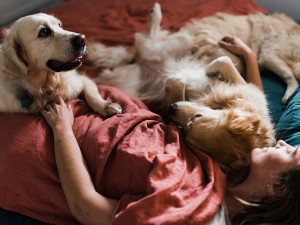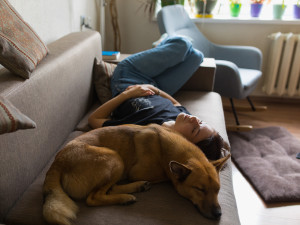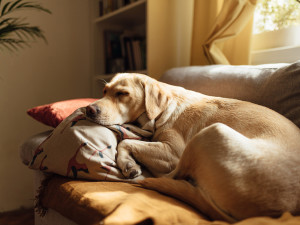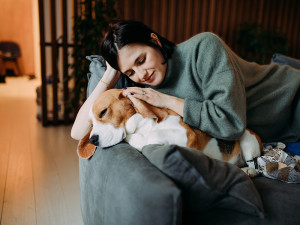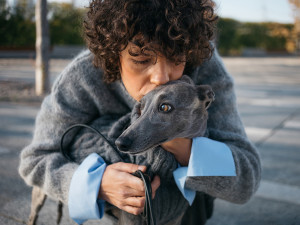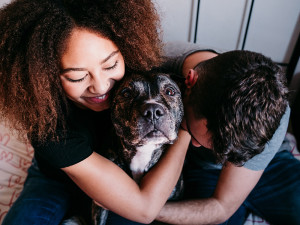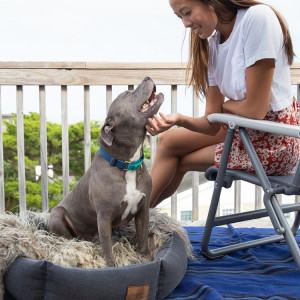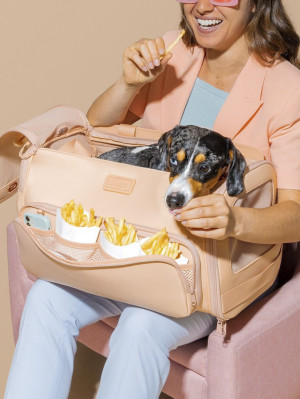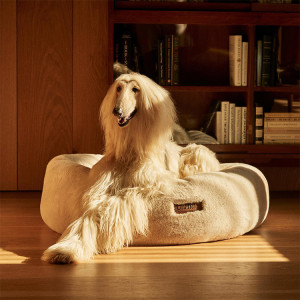Where Should Your Dog Sleep at Nighttime?
It’s a personal preference, but here are the pros and cons.
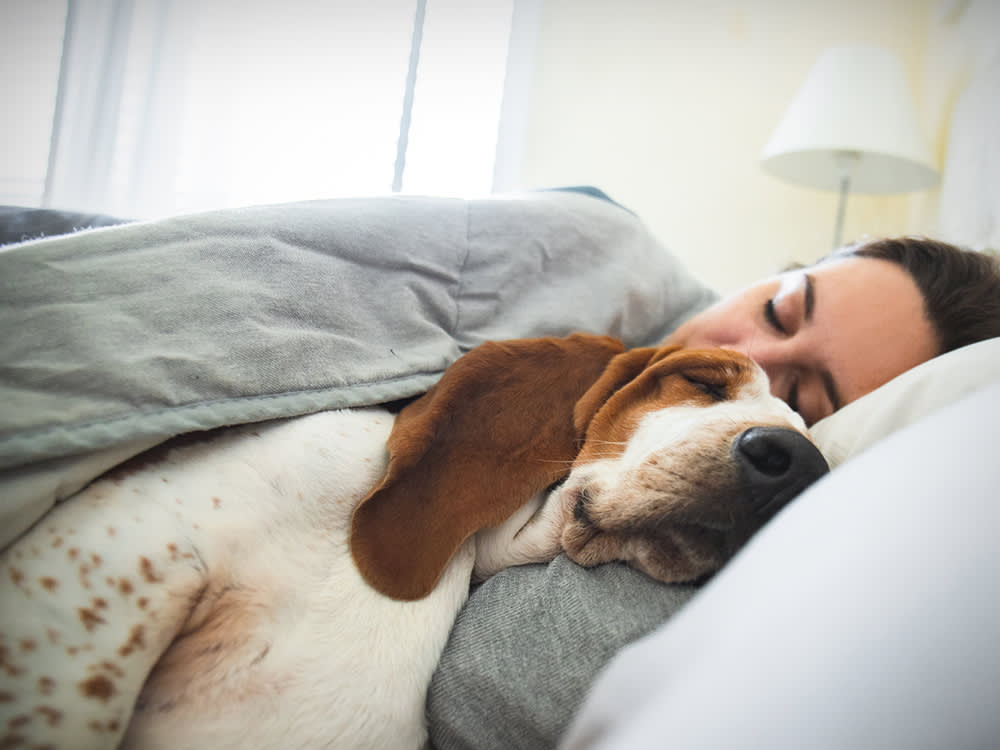
Share Article
Like humans, dogs are social animals. Most of them feel comfortable being near the rest of the family and that includes at nighttime. Many people have their dogs in their room on a dog bed, in a crate, or on the floor by the bed. Others like to have them to sleep on the foot of the bed.
Still, others snuggle with their pup right next to them, even under the covers. They keep you cozy while making you feel safe, secure, and loved. It’s a wonderful feeling to have dogs snuggle up at night, or even during a nap. Indeed, 45 percent of people say they allow their dog to sleep in their bed, according to a survey opens in new tab by the American Kennel Club. Despite how common this is, there are still many people who ask if you should you let your dog sleep with you.
With so many dogs sleeping in our beds, isn’t it about time we throw away the guilt so many people feel about having their dogs share the same sleeping space? I talk to pet parents every week who apologetically tell me their dog sleeps with them. They often share this information as though they are making a confession, and many say, “I know I’m not supposed to, but I let my dog sleep with me.” Somehow, the cultural consensus is that sleeping with your dog in bed is a problem.
It’s sad how many people feel bad about letting their dogs up to sleep on the bed at night when that decision is totally theirs to make. Far too many people feel judged about it, but it’s good to see they are making their own choices about letting their dog sleep with them, because that’s what it is — a choice.

There are many factors that can help people make a well-informed decision about where to have their dog sleep, but the judgment of other people should not be one of them.
Dog sleep habits
How many hours do dogs sleep?
The average sleep time for dogs is in the range of 12 to 14 hours a day, a figure that refers to adult dogs. Puppies need even more sleep — 15 to 18 hours is not unusual for them. Because dogs need more sleep all day than people do, it is usually easy to sync our nighttime with theirs. Most dogs will sleep at night when we do and then get their napping in throughout the day as needed.
Do dogs sleep all night?
Most adult dogs sleep all through the night, though they can be woken up by loud noises, by being touched, or if they are uncomfortable for any reason. Many senior dogs do wake up in the middle of the night, sometimes because they need to pee. Puppies frequently wake up during the night, though many of them will sleep till morning once they are in the range of four to six months old.
Should I consider my dog's age when deciding on their sleeping area?
Your dog’s age can influence where you choose to have them sleep. Dogs at different stages of their life merit different considerations when you decide where they should sleep.
Where should puppies sleep?
Puppies can easily get themselves into trouble while we are sleeping and therefore unable to supervise them. That’s why I like to have puppies sleep in a crate. That way, they aren’t going to chew up household items, and if they do have an accident, it’s at least confined to one area. My preference is to have the crate in the bedroom so the puppy has company. They are social and are more likely to feel safe and secure near you. Also, that way, you are more likely to respond if they become upset or wake up and have to go outside to pee. If you are not using a crate, you can consider confining them in the room with you or putting them in a puppy pen in your room.
Some puppies grow up sleeping in a crate and remain most comfortable and happy in one throughout their life. Others prefer to be on the floor, in a dog bed, or on the bed with you as they age. Once they are old enough that it’s safe for them to sleep without being confined, whether you stop having them sleep in the crate or not depends on what makes you happiest and what makes your dog happiest. Continuing to sleep in a crate during the first year or two is common because many dogs are less likely to chew things they shouldn’t by that time.
Where should adult dogs sleep?
Most adult dogs are happiest if they sleep in the same room as you. As social animals, it can be stressful for many of them to be separated from everyone else in the household at night. Within your room, they can be in a crate if they like being in one, on a comfortable dog bed on the floor, or up on the bed with you. The primary goals are to keep everyone happy and to allow everyone to have a restful night of sleep. If that means having the dog in the bed with you, your dog will likely be very happy about that. If they prevent you from getting adequate Zs, then having them in a crate or on a dog bed rather than up in your bed are better options for everyone.
Where should senior dogs or dogs with health problems sleep?
Senior dogs or dogs with health problems should sleep wherever they are most comfortable. If that means up on the bed (and they don’t ruin your nights), that’s great. If that means on the floor by your bedside, that is a wonderful option. It is especially important to provide dogs in any pain with the bedding that eases their discomfort. That may mean a soft, cushioned bed, or it may mean a dog cot that is raised off the floor to allow better air flow. Some dogs with health issues, or those who are old, may need help getting on and off the bed — or even on and off a dog bed. Make sure you help them if they need it, especially as they age.
Advantages of sleeping with your dog
There are many reasons to let your dog sleep with you: Dogs typically like to sleep with us. They are less likely to become stressed, either from being alone or in response to something startling, like lights from cars going by or a thunderstorm. In the morning, you’ll know when they have to go out right away — or if they are sleeping in that day.
If your dog is in or on your bed, any cold weather will seem a lot less harsh with a living furnace right next to you. Sharing sleep is one way to feel really close to each other, and that’s always a plus. Sleeping with your dog:
Promotes theta brainwaves
Increases sense of security
Eases insomnia
Maximizes comfort
Decreases loneliness
Improves sleep quality
Reduces stress
Lowers blood pressure
Strengthens your relationship
Disadvantages of sleeping with your dog
On the downside, some people find a dog in their bed keeps them awake, either because the dog snores or because there is not enough room in the bed or enough covers to go around. It can cause considerable friction in a relationship if one member of a couple loves having a dog on the bed and the other person doesn’t. Other reasons to keep your dog out of your bed may include:
Your dog isn’t house trained
You have severe allergies
You are a light sleeper
You have a new dog
You or your dog have health issues or open wounds
To learn more so you can make the best choice for you and your dog, read about the effects of sleeping with your dog.
Advantages of dogs sleeping in crates
Crates offer so many benefits for dogs that it is common for trainers and behaviorists to joke about writing an ode to a crate if they were ever required to write a poem. I will not lapse into poetry here, but I will share some of the advantages of having a dog sleep in a crate.
Crates help keep your dog and your house safe.
Crates keep dogs and houses safe. Dogs can find danger in the form of electrical cords, food that’s not good for them, and things that are not even food but can be swallowed. Having a dog sleep in a crate protects them from these dangers while you are sleeping and unable to supervise your dog. Similarly, dogs who are loose at night may eliminate indoors, chew up a family heirloom, or attempt to remodel your house by treating the door frame as a toy. Crates solve these problems.
Crates are good for travel.
If your dog is used to sleeping in a crate, it makes traveling easier. Wherever you go, whether you are visiting friends, at a hotel, or staying in a camper, your dog can sleep in the crate. Since this is just what they do at home, they are likely to have an easier time adjusting to life on the road. A dog who can easily travel is a dog who is more likely to get to come along on trips.
They are great at the vet, the groomer, or in case of emergency.
Dogs who are used to crates are less stressed when they have to go someplace new and are put in a crate. If your dog is used to sleeping in a crate, it is likely they will have an easier time handling a potentially stressful outing. Stressful outings can include being at the veterinarian or at the groomer. They could also include a situation in which the whole family has to evacuate because of a natural disaster. I hope it never happens to you, but if you do have to evacuate, it will be far easier on your dog if they are used to sleeping in a crate because they may need to be in one at a shelter or other temporary housing.
Disadvantages of dogs sleeping in crates
Dogs are individuals, and not every one of them likes crates as much as I do. Some dogs dislike being in a crate, and if that’s true of your dog, then they shouldn’t be asked to sleep in one. It’s still a good idea to teach them to be as comfortable as possible in a crate because of the advantages of that, but they do not need to sleep in one regularly.
Some dogs become upset when in a crate.
There’s nothing wonderful about having a dog in a crate who is unhappy there. There are dogs who bark or whine when put in a crate, and that’s not good for anybody’s sleep. Other dogs salivate or pant, or show other signs of distress. Yes, crates offer advantages related to safety and convenience, but those pluses can easily be outweighed by the negatives if a dog dislikes being in one.
Dogs can’t make choices.
Dogs who are in crates cannot make all the choices they can when they are out of a crate. Their agency is taken away by being confined. A crated dog can’t choose to be in a different area of the room where the temperature is different or there is a breeze (or isn’t a breeze) coming through the window.
They can’t walk around if they feel like it. The crate prevents much of their freedom, which is what they are designed to do. For many dogs, that leads to a sense of safety or perhaps they don’t care one way or the other. But dogs who do care about having choices, a crate puts uncomfortable limits on them.
It takes up a lot of space.
A major disadvantage of crates is that they take up so much space. I’ve lived in some small houses. None were straight up tiny houses, but they were small enough that I asked my artist mother-in-law to paint a sign that says, “Love grows best in little houses.” Love and little houses are a great combo, but crates and little houses are not. In small houses, or houses with small bedrooms, the space occupied by a crate can be a huge inconvenience, especially if the size of the dog necessitates a large crate.
What are some alternative sleeping arrangements for my dog?
Your dog might not want to sleep in a bed, but there are other options where your dog can safely get a good night's sleep. Your dog might want to sleep in their crate, at the foot of the bed, or in another cozy spot of their choosing.
Should my dog have their own bed?
Yes, at least one. I love for dogs to have choices about which bed they like. The location of the bed, as well as the style of bed, may influence your dog’s preference for sleeping (or resting) there. I like to have at least one dog bed on each floor of the house, and I prefer for there to be multiple options in the room where they sleep.
Many dogs like big, flat dog beds, while others prefer donut beds or other option with something to lean against. Dogs have preferences for the size of their bed, too, and it always amazes me how many big dogs actively choose a small bed to curl up in even when a much larger bed is available. Just as we have many options for where to sit — couch, armchair, straight back chair, or even a bean bag, many dogs delight in various options when it comes to their own furniture. When it’s cold, they may choose a fluffy bed, but gravitate toward a cot dog bed in warmer weather.
Can dogs sleep outside?
It’s not generally recommended that dogs sleep outside. That exposes them to temperature extremes and to dangers from wildlife, and makes them vulnerable to someone taking them. Additionally, many dogs act like they are on sentry duty when they are left outside. Being vigilant and on guard is stressful for them. It’s far better to avoid these issues and have them inside to sleep.
One exception to this is dogs who have lived outside all their lives, perhaps as strays, before being adopted. These dogs sometimes prefer to be outside, perhaps finding the massive change to a life indoors too overwhelming. With these dogs, it is good to teach them to be comfortable indoors for their own safety and to build a closer relationship, but they should not be forced to come inside if they are too scared or otherwise uncomfortable to do so on their own.
How can I make my dog comfortable while sleeping?
The best way to make a dog comfortable while sleeping is to give them choices about where to sleep. If they choose to sleep on the bed with you, or on the floor, or on a dog bed, or in a crate, they are likely comfortable there. Whether your dog sleeps at the foot of the bed, your dog sleeps under the bed, or your dog sleeps under the covers with you, their choice tells you they want to be there.
Other ways to make your dog comfortable are to provide them sleeping conditions that suit them. That includes soft beds, cushioning, or blankets. It’s also important to keep the room a comfortable temperature. Just like people, dogs sleep better when the temperature is right, though that can vary for individual dogs. The most important action most of us can take to make our dogs comfortable while sleeping is to have them near us, in our room, and perhaps in our bed. That’s great news because so many of us are most comfortable with a sleeping dog in the bed, too.
References:

Karen B. London, PhD, CAAB, CPDT-KA
Karen B. London is a certified applied animal behaviorist (CAAB) and certified professional dog trainer (CPDT) who specializes in working with dogs with serious behavioral issues, including aggression. She has written for a variety of magazines including The Bark, Clean Run, and the APDT Chronicle of the Dog, and has published in scientific journals including Behavioral Ecology and Sociobiology, Ethology, Ecology, and Evolution, the Journal of Insect Behavior, and Insectes Sociaux. She is the author of seven books about dog training and canine behavior, including the forthcoming My Dog's Mystery Adventure: And Other Stories From a Canine Behaviorist and Dog Trainer.
Related articles
![a human petting a dog on a dog bed]()
The Best Dog Beds Of 2025
Our dogs sleep with us, too. But these trainer-recommended dog beds—from indestructible ones for puppies to orthopedic options for seniors—are the next best thing.
![A woman with a pink dog carrier on her lap feeding a dog a French fry.]()
Terrified of Your Dog’s Impossible-to-Assemble Crate?
Diggs has the answer.
![a human petting a dog on a dog bed]()
The Best Dog Beds Of 2025
Our dogs sleep with us, too. But these trainer-recommended dog beds—from indestructible ones for puppies to orthopedic options for seniors—are the next best thing.
![Long haired dog sitting in dog bed]()
UnHide’s Faux Fur Dog Bed Is the Stuff Doggie Dreams Are Made of
And the rest of their products are pretty heavenly, too.
![A dog jumps on a blue-and-white patterned bed, surrounded by dirt. An illustrated white fence and carrots are in the background.]()
Kingboy Makes Dog Beds That Only Royalty Deserves
Royalty, aka all dogs.
![Small grey dog lays on beige dog bed.]()
Zara’s Pet Collection Is Giving Montessori Influencer Vibes
For those who love a beige moment.
